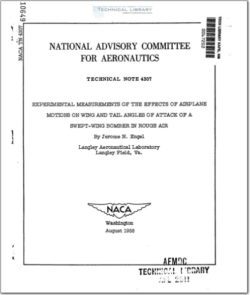NACA-TN-4307

- Version
- 186 Downloads
- 800.78 KB File Size
- 1 File Count
- December 4, 2015 Create Date
- December 4, 2015 Last Updated
National Advisory Committee for Aeronautics, Technical Notes - Experimental Measurements of the Effect of Airplane Motions on Wing and Tail Angles of Attack of a Swept Wing Bomber in Rough Air

Flight test data obtained from a large swept-wing bomber airplane
in flight through rough air at an altitude of 5,000 feet are analyzed
to determine the effects of vertical translation and pitching motions
on the angles of attack of the wing and tail. Power-spectral techniques
are used to determine the contributions of these motions to the angles
of attack of the wing and tail at various frequencies, and the results
are compared with the direct gustninduced angle of attack.
The results indicate that the motions, particularly the pitching
motions, significantly amplify the angles of attack of the wing and tail
for the test airplane. The pitching-motion component increases the root-
mean—square angle of attack of the wing by about 55 percent and the root-
mean—square angle of attack of the tail by about 50 to 60 percent.
The effects of airplane longitudinal motions, particularly the
pitching motions, on the loads or angles of attack of the wing and tail
of an airplane in flight through rough air have long been of concern.
A number of analytic studies (for example, refs. 1 and 2) have indi—
cated that the motions may contribute substantially to the airplane
loading. The evaluation of these motion effects experimentally, how;
ever, has been complicated by the continuous and random character of
both the turbulence and the resulting airplane motions. As a consequence,
few experimental data exist on the subject.
As part of an investigation of the effects of airplane flexibility
on the strains in rough air for a large swept—wing bomber airplane
(ref. 3), time—history measurements of the vertical gust velocity and
the longitudinal airplane motions were obtained. These measurements
provided an opportunity for evaluating the effects of the longitudinal
motions on the loading or angles of attack of the wing and tail for the
test airplane; consequently, an analysis of these measurements was under-
taken. In the present report, power-spectral methods of analysis are
applied to the test measurements in order to determine the direct con-
tributions of the airplane vertical velocity and pitch responses to the
angles of attack of the wing and tail at the various frequencies during
flight in rough air. The techniques used in the analysis and the results
obtained are presented.
| File | Action |
|---|---|
| naca-tn-4307.pdf | Download |

Comment On This Post